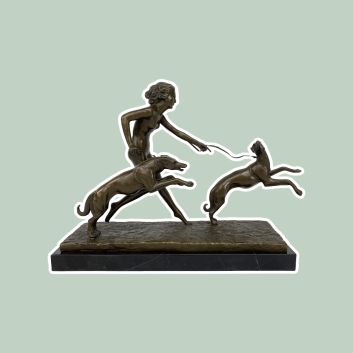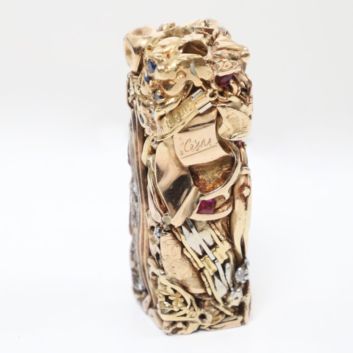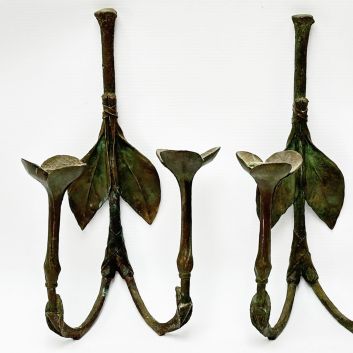Rating and value of works, sculptures, bronzes by Robert Couturier

If you own a work by or after Robert Couturier, and would like to know its value, our state-approved experts and auctioneers will be happy to offer you their expert appraisal services.
Our specialists will carry out a free appraisal of your work, and provide you with a precise estimate of its current market value.
Then, if you want to sell your work, we'll point you in the right direction to get the best possible price for it.
Rating and value of Robert Couturier's works
Robert Couturier has produced some unique sculptures. Nowadays, prices for these creations can rise considerably under the auctioneer's hammer. His sculptures are particularly prized by buyers from all over the world.
The price at which they are selling on the art market ranges from €6,800 to €70,000 at the moment, a considerable difference but one that says a lot about the value that can be attributed to Robert Couturier's works.
In 2010, his bronze sculpture Jeune femme lamelliforme, dating from 1951, sold for €98,000, originally estimated at €80,000 to €100,000.
Order of value from the most basic to the most prestigious
Technique used | Results |
|---|---|
Print - multiple | From €20 to €200 |
Drawing - watercolor | From €120 to €1,500 |
Luminaire | From €2,800 to €11,000 |
Sculpture - volume | From €60 to €98,000 |
Response in less than 24h
Style and technique of artist Robert Couturier
Robert Couturier's style is characterized by pure elegance and a refined sense of form. From the outset of his career, he favored simple lines and harmonious volumes, avoiding excessive detail in favor of an almost abstract purity.
His approach is marked by a desire to go straight to the essentials and sublimate them, reducing his works to fluid, well-balanced forms, in keeping with a fairly contemporary approach that other artists had also chosen before him.
Couturier works mainly in plaster, a medium he favors for its malleability and ability to radiate in a luminous space. He models this material with great delicacy, creating airy sculptures that are always very light in appearance.
Unlike many of his contemporaries, he rejects heaviness, preferring light compositions in which emptiness plays a central role. Every curve is carefully thought out, every empty space becomes a structuring element. Couturier thus questions the relationship between emptiness and matter.
It's a central question in modern sculpture, and one that's also present in the work of artists such as Bruno Catalanowho based his creative process on a chemical error, also giving the vacuum a prominent role in his work.
For Couturier, research is directly linked to experimentation and working with materials, which demands patience and dedication. The artist calculates, feels and shapes until he achieves the balance he seeks between the deployment of matter and the presence of emptiness.
This meticulous process enables him to create works of great sobriety, yet imbued with a subtle emotional power, where every detail counts without ever overloading the whole.


Robert Couturier's career
Robert Couturier is a contemporary sculptor who works mainly in bronze. The sculptures that sell on the auction market do not exceed one meter in height, although he has produced a number of monumental works for public commissions.
Robert Couturier, born in Angoulême in 1905, is a French sculptor who has established himself as a major figure in contemporary art in France. From the outset, Couturier's style was both innovative and refined, deeply influenced by his personal experiences and observations of the world around him.
His artistic career began in earnest when he entered the École des Beaux-Arts in Paris in 1924, where he was trained by masters of classical sculpture - a training that was not directly reflected in his work, but was nonetheless essential.
However, it was his time with the artist Antoine Bourdelle that marked a decisive turning point. Under the tutelage of this great sculptor, Couturier developed a fascination for pure forms and balanced volumes, elements that would become the hallmark of his work.
After several years of apprenticeship, Couturier opened his own studio, a space where he gave free rein to his creativity. He soon moved away from academic canons to explore a more personal style, playing with materials to create sculptures of great sobriety, yet astonishing expressive power.
Plaster is her material of choice, enabling her to model airy, poetic forms in a constant search for harmony between man and nature.
In 1947, he exhibited at the Salon d'Automne, where his work was hailed for its originality. From then on, Couturier began to explore more abstract compositions, while retaining his intimate link with the human figure.
His sculptures, though stylized, continue to reflect a great sensitivity to line and light.
Over the decades, he has asserted his singular style, characterized by a formal simplicity that in no way detracts from the emotional depth of his works.
Robert Couturier - Silhouettes
Focus on the bronze cover by Robert Couturier
Robert Couturier's sculpture presented here testifies to his unrivalled mastery of form and his ability to infuse subtle emotion into the simplicity of his work.
At first glance, this figure, seated in a meditative posture, seems solidly anchored in the surrounding space. However, beyond this motionless appearance, Couturier succeeds in capturing a moment of profound contemplation.
The body, despite its simplicity, is inhabited by an almost imperceptible tension, a kind of silent reflection that manifests itself in the character's attitude.
True to his style, Couturier chose clean lines, avoiding any overload of detail. The forms are fluid and the contours softened, giving this figure an impression of airy elegance.
This economy of means is not an easy choice, but a quest for the essential: the figure doesn't just represent a human body, it transcends mere materiality to evoke a mental presence.
The material, probably bronze in this case, reinforces this impression of light gravity. Couturier plays with the reflections and texture of the material to create zones of light and shadow, as if to suggest his subject's inner world, that universe of thought suspended in silence.
This slightly irregular, tactile surface encourages the observer to linger, to explore the smallest details that emerge from this apparent simplicity.
The face, barely sketched, expresses a mysterious interiority. Unlike other artists, who might have sought to give a more explicit expression, Couturier leaves his character in a kind of abstraction, where we can read introspection as much as passive observation.
This choice gives the sculpture a universal appeal, with each viewer projecting his or her own reflections onto it.
This work perfectly embodies Robert Couturier's approach, which, far from excess, achieves a rare depth by concentrating on the essence of form and emotion. It illustrates his talent for transforming a familiar scene into a timeless reflection, where simplicity becomes synonymous with grandeur.

The legacy of Robert Couturier
The success of Robert Couturier's sculptures was evident from his very first exhibitions. His works, characterized by clean lines and balanced forms, quickly attracted the attention of a discerning public.
Over the years, Couturier has perfected his approach, while remaining true to his simple, refined aesthetic. Each new piece bears witness to this quest for the essential, without ever straying from his characteristic technique.
His light, airy sculptures are captivating in their sobriety and mastery of volume.
His work follows in the artistic vein of other equally famous sculptors, such as Diego Giacometti, Igor Mitoraj or even César.
Robert Couturier, however, is an even more versatile artist, who did not concentrate solely on creating decorative sculptures. In fact, some of his works are also utilitarian.
This is the case for many of his creations, including lighting fixtures and furniture: among others, he has produced bronze tables topped with a glass top.
Today, Couturier is recognized as one of the most important contemporary sculptors of his time. His works are particularly prized by collectors, and although few of them appear at auction, they fetch high prices when they do.
Robert Couturier's unique style and fine craftsmanship ensured him a place of choice in the world of modern art.
Recognizing Robert Couturier's signature
Robert Couturier doesn't always sign his works. If you think you own one, it's best to have it appraised.

Appraising your property
If you own one of Robert Couturier's works, don't hesitate to request a free appraisal by filling in our online form.
A member of our team of experts and certified auctioneers will contact you to provide an estimate of the market value of your work.
If you are considering selling your work, our specialists will also guide you through the various alternatives available to obtain the best possible price, taking into account market trends and the specific features of each work.
Response in less than 24h
Related topics

Rating and value of works, drawings, paintings by Constantin...
Constantin Terchkovitch is a Russian painter associated with poetic realism who produced drawings and canvases that are highly prized and sought-after at auction.
Read more >

Cote et valeur 2024 des tableaux, dessins, sculptures de Mic...
Michelangelo Pistoletto is an Italian artist of the Arte Povera movement who has produced many works that are highly valued at auction.
Read more >

2024 quotation and value of sculptures, drawings and paintings by Je...
Jean Louis Toutain is a contemporary sculptor who has produced works that are highly rated and valued at auction. Estimate in 24h.
Read more >
Secure site, anonymity preserved
State-approved auctioneer and expert
Free, certified estimates





